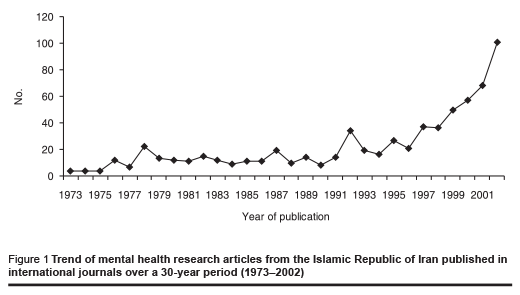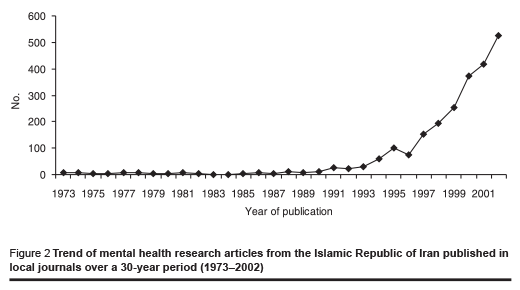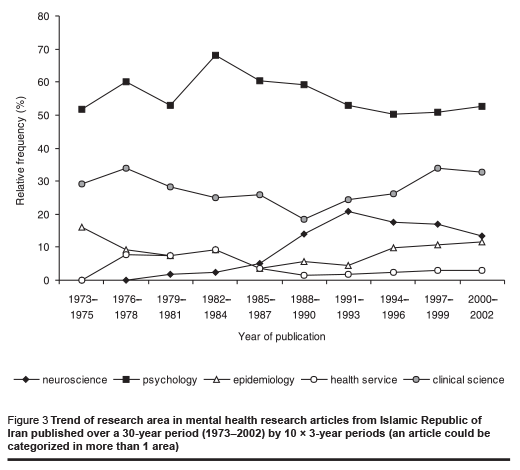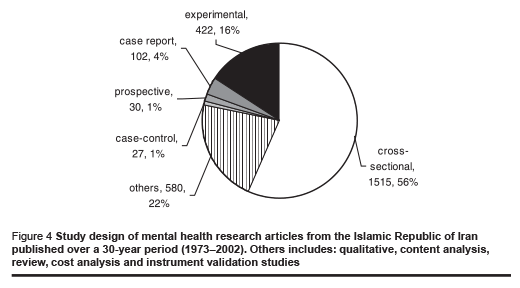V. Sharifi,1,2 A. Rahimi-Movaghar,2,3 M-R. Mohammadi,1,2 R.R. Goodarzi,2 E.S. Izadian,2 A. Farhoudian,2 N. Mansouri2 and A-A. Nejatisafa1,2
ABSTRACT This study described the characteristics of mental health research from the Islamic Republic of Iran published from 1973–2002. Research articles in psychiatry, psychology and neuroscience published in local or international journals were drawn from IranPsych, a national database of research in mental health and related disciplines. Of 3113 articles, 21.8% appeared in international journals, but there was international collaboration among the authors in only 2.3%. There was a marked increase in the number of publications over time, especially in the last 5 years. Analysis of research areas showed a proportionate rise in neuroscience research and a decline in mental health service research. Our study provides an empirical basis for policy-making and strategy planning in the nation’s mental health research.
Analyse de la recherche en santé mentale en République islamique d’Iran pendant trois décennies : étude scientométrique
RÉSUMÉ Cette étude décrit les caractéristiques des travaux de recherche en santé mentale en République islamique d’Iran publiés de 1973 à 2002. Des articles de recherche en psychiatrie, en psychologie et dans le domaine des neurosciences parus dans des journaux locaux ou internationaux ont été tirés d’IranPsych, une base de données nationale sur la recherche consacrée à la santé mentale et aux disciplines connexes. Sur 3113 articles, 21,8 % ont été publiés dans des journaux internationaux, mais seuls 2,3 % ont été rédigés par des auteurs ayant collaboré à l’échelle internationale. Le nombre de publications a nettement augmenté d’année en année, notamment au cours des cinq dernières années. L’analyse des domaines de recherche a montré une hausse proportionnée de la recherche dans les neurosciences et un recul de la recherche relative aux services de santé mentale. Cette étude constitue une base empirique pour l’élaboration des politiques et la planification des stratégies dans le domaine de la recherche en santé mentale au niveau national.
1Department of Psychiatry, Roozbeh Hospital; 2Psychiatry and Psychology Research Centre, Roozbeh Hospital; 3Iranian National Centre for Addiction Studies, Tehran University of Medical Sciences, Tehran, Islamic Republic of Iran (Correspondence to V. Sharifi:
Received: 10/07/06; accepted: 03/09/06
EMHJ, 2008, 14(5): 1060-1069
Introduction
Research into mental health disorders is urgently needed in developing countries because of the imbalance between the burden of mental disorders and the resources for managing them in these countries [1]. In addition, there is a large gap between the research information that is needed and what is currently available [2]. Therefore, a prerequisite to strategic research planning and policy-making in any country should be the knowledge of the status of research in that country. This is especially important for developing countries that have limited resources and capacity for research.
The Islamic Republic of Iran has substantially increased its presence in world science in recent years [3,4]. According to papers indexed by the Institute for Scientific Information (ISI), the Islamic Republic of Iran’s output in science, although still comparatively small, more than tripled from 1996 to 2002 [4,5]. This holds true in mental health and related disciplines, where a myriad of papers have been published in local and foreign scientific journals. However, until recently, the country lacked a database for its mental health research publications. Studies of the research activity of a country that rely solely on publications indexed in international databases such as ISI, MEDLINE or PsycLIT, miss a great deal of data that are published in local journals that are not indexed in such databases [5].
To our knowledge, there has been no comprehensive analysis of mental health research activities in the Islamic Republic of Iran and there are few examples from other developing countries [e.g. 6]. This contrasts with a number of scientometric studies in industrialized nations such as the United States [e.g. 7], the United Kingdom [e.g. 8] and Italy [e.g. 9]. This study therefore aimed to describe the characteristics of mental health research from the Islamic Republic of Iran published in national or international journals over a 30-year period (1973–2002). This was made possible following the recent development of a national database of published research in mental health and related disciplines, entitled IranPsych.
It was hoped that the study would allow for the identification of particular areas of need and could provide a basis for research planning and policy-making.
Methods
The articles were drawn from IranPsych, a national database of published research in mental health and related scientific fields that includes psychiatry, psychology and neuroscience [10]. This database was developed at the National Research Centre for Medical Sciences of Iran by the authors, and gathers scientific papers that are published in both local and international journals.
The international papers in this database include those indexed in ISI (Web of Science), MEDLINE or PsycLIT that are written by author(s) affiliated with a centre in, or have described data obtained from, the Islamic Republic of Iran. Local papers are published in peer-reviewed journals that are supervised by the Scientific Journal Commissions of the Ministry of Science and Ministry of Health; among these local journals are more than 20 that primarily address psychological and psychiatric issues, as well as several others on general topics such as medicine and basic sciences that may publish papers related to mental health. Research articles were limited to those published in a 30-year period (1973–2002), for which the coverage of the publications in IranPsych is most complete. For the purpose of this study, research articles were defined as those that presented first-hand data collected in a systematic fashion and that included some clearly defined methodology, including empirical articles, review articles, theoretical articles and case reports.
The following data were collected from the articles: bibliometric data including year of publication and source of the article, status of collaboration among the researchers (authors), general scientific area of research, specific subject topic, research design, location of data collection and funding source. It should be noted that in all these types of data (with the exception of research design), an article could be rated in one or more categories.
Five psychiatrists and a psychologist with a master’s degree collected the data. All participated in an intensive training programme where they rated several articles and discussed the ratings and reached a consensus for the definition and ratings of categories. In addition, throughout the study, weekly sessions attended by all the raters were held to discuss the ambiguities and to reach consensus. Inter-rater reliability was evaluated and showed an overall agreement of 84% on the rating of study variables.
Ratings were made using full-text articles with the exception of 437 papers (all published in international journals) for which full texts were not available. In these cases, ratings were made using the abstracts of the papers, but some data were not assessed (including, research methodology, location of data collection and source of funding); the analyses for these data were made based on the remaining articles.
Results
From the total of 3113 articles published in the 30-year period, 680 (21.8%) appeared in foreign (international) journals and the remainder were published in local journals that are not indexed in international databases. In 14.5% of the articles there was collaboration among professionals in mental health and other disciplines, and in only 2.3% of the articles was there any international collaboration among the authors. In 875 papers (28.1%) there was a single author, and the average number of authors was 2.44 for all papers (2.32 for local and 2.88 for international papers).
Figures 1 and 2 illustrate the trends of publications over time in international and local journals, respectively. Analysis of publication trends shows a marked increase in the number of publications over time, especially in the last 5 years, showing a 2.7fold increase in international and 3.4-fold rise in local publications.


Among general research areas, psychology and clinical research had the largest share, with 1637 (52.6%) and 968 articles (31.1%), respectively. Neuroscience, epidemiology and health services research articles were the other major areas, with 445 (14.3%), 325 (10.4%), and 97 articles (3.1%) respectively. The proportion of research in different research areas showed a rising trend in neuroscience research and a decline in mental health service research in the last 20 years (Figure 3). However, the decline pertained only to the relative and not the absolute frequency of the articles, as the latter showed increases in all areas.

With respect to the specific subject topics, 1195 articles (38.4%) were in the category mental disorders, with somatic treatments and psychosocial treatments being the topic in 445 (14.3%) and 175 (5.6%) articles, respectively. Among mental disorders, the largest proportions of published research were about mood disorders, disorders related to substance use and anxiety disorders. The frequencies of articles concerned with mental disorders are shown in Table 1.
The most commonly used research method was cross-sectional, with prospective research accounting for only about 1% of the published articles (Figure 4). It should be mentioned that the methods used in the neuroscience articles were not analysed here; however, it is known that most had experimental designs.

Hospitals, schools, laboratories and universities were the most preferred locations for data collection, with 594 (22.1%), 496 (18.5%), 464 (17.3%) and 277 articles (10.3%) respectively. Only 64 papers (2.4%) collected data in subjects’ homes. Other locations included doctors’ offices, outpatient clinics, residential centres, prisons, counselling centres, other workplaces and other health centres. Some papers did not specify the location of their data collection (n = 326, 10.5%).
In 2445 articles (91.4%) there was no reference to the funding source, and 189 articles (7%) reported national governmental centres as the source of financial support. The private sector (non-industrial) and foreign research centres contributed to the funding of only 2 (0.07%) and 19 articles (0.7%) respectively. The remaining papers indicated receiving some financial support yet did not specify the source. There was no support for research reported from industry sources, whether government or private.
Discussion
The present study aimed to provide a picture of the status and trends of mental health research activity in the Islamic Republic of Iran over the years 1973–2002. Of 3113 articles published in this period, more than 78% appeared in local journals not indexed in international databases. This is in line with the fact that databases such as ISI or MEDLINE represent a small proportion of the research done in developing countries. For example, a study conducted in China showed that one-tenth of Chinese articles were indexed by MEDLINE [11]. Therefore, any scientometric study undertaken on exclusively indexed articles can not represent the total research activity of a country. Collaboration among researchers across disciplines, organizations and countries is known to be an indicator of the progress in science and is widely praised [1]. In about one-seventh of the articles analysed there were collaborations between professionals in mental health and other disciplines. This could have resulted from the gains in importance of mental health issues among medical professionals other than psychiatrists, which has been quite welcomed in recent years. However, the small proportion of international collaboration among the authors (about 2%) is of great concern. Collaboration in research at the international level may lead to capacity-building and improvement in the quality of research. A similar low rate of international collaboration has been observed with regard to the Islamic Republic of Iran’s total publications in MEDLINE reaching no more than 10% of the country’s output [12].
The trend of publications showed an upwards trajectory both in local as well as international publications, especially in the last 5 years. This is paralleled by the striking rise in the Islamic Republic of Iran’s production of science research papers over the last decade. A study on those publications indexed in ISI revealed that the production rose from 0.03% of the world’s scientific output in 1991 to 0.29% in 2003, which indicates about a 10-fold increase in less than 15 years [5]. In a comparable study on mental health research in the Arab world, it was shown that Saudi Arabia has been the most productive Arab country with 11.4 articles per year in 1986–1996 [13]. For the purpose of comparison, we analysed the Islamic Republic of Iran’s international mental health output in the same period, and found that the publication rate reached 17.5 articles per year.
Several factors might have contributed to this achievement. Following the end of the Iraq–Iran war in 1988, the number of universities, faculty members and graduate students increased, postdoctoral graduates returned to the country, doctoral programmes expanded in several universities, investment in the research sector increased, incentives were made for research publications, several research centres were established within universities, and a multitude of local journals began publication, many of those with a special focus on mental-health-related issues.
However, there remains a question as to whether the surge in publications has been paralleled by a rise in the quality of the published articles, as promotion of good quality research is more important than simply facilitation of the publication of research. We were not able to answer this question in the present study, and this would be an important topic of future research using critical appraisal and citation analysis methodologies.
With regard to the general area of research, most of the articles belonged to psychology and clinical research and only about 3% dealt with health service research. This differs from a study of publications from some developing countries [1], and to another in the United States [7]; in both studies, service research constituted more than 10% of the articles. Mental health service research is especially needed in developing countries, where service needs are paramount and the limited resources should be spent on finding ways to improve the health status of the population. Surprisingly, the trend analysis showed a decline in the share of mental health service research in the last 2 decades. This drop is in contrast to the emphasis on improving the mental health services and integration of the services into primary care that occurred in the Islamic Republic of Iran in the period after the Iran–Iraq war [14]. Research focusing on mental health services is no less important than biological research, and may be more relevant to answering the mental health needs of lowand middle-income countries [1]. The reason for this decline should be scrutinized and ways to overcome the problems should be probed. However, we should note that many evaluations of mental health programmes and services are ordered by government bodies and might not be published. The second reason could be the publication bias toward biological research in several scientific journals. In contrast to the mental health service research, there was a surge in the share of neuroscience publications that is in keeping with several studies in other countries showing a continuing rise in the proportion of biologically oriented research in psychiatry [7].
Among the specific subject topics, more than one-third were devoted to mental disorders, among which mood disorders and substance-related disorders were the most important. Others have also found that substance-related disorders are the most frequent research topic in lowand middleincome countries, including Arab countries [1,6]. It should be noted that the prevalence of drug abuse/dependence is very high in the Islamic Republic of Iran [15] and this could have attracted more support for such research.
The most common research design was cross-sectional research, comprising more than half the articles. The immediate applicability and feasibility of this type of research could have been a driving factor, as well as the “publish or perish” mentality in academic settings, which has reduced the capacity to conduct longitudinal or prospective studies [7]. This is evident in the proportion of prospective research, making up only about 1% of the articles. We could compare it to the proportion of prospective research in American psychiatry that was about 16% of the published research in 1989–1990 [7].
With regard to the location of data collection it seems that most researchers preferred places as near as possible to themselves; e.g. hospitals, universities and laboratories. Subjects’ homes were the location of data collection for just 2.4% of the research articles (mostly in epidemiological studies). This raises concern that the feasibility of research might be a prime factor influencing the research design and data collection.
Another important finding of the study was the absence of any reference to the funding sources in more than 90% of the articles. The most likely reason may be lack of acknowledgement by the researchers despite the presence of financial support. None of the articles reported support from industry. Funding by industries is a neglected area in developing countries, not only in mental health but also in most scientific and medical disciplines [13].
The findings of our study should be viewed in the light of its possible limitations. The source of the articles for this study was the IranPsych database that included both national and international publications. However, it is possible that some publications might not have been indexed in IranPsych. In addition, limiting research reports to only published ones might not be completely representative of all research activity. However, published research is considered to best represent overall research activity, and we believe that IranPsych is the most comprehensive database for mental health research in the Islamic Republic of Iran. Another limitation is the nature of the classification of the articles into research areas and subject topics. Any such classifications would have limitations. However, we reached good reliability among the raters who did the categorizations.
In conclusion, there has been a rising trend for both national as well as international mental health publications, especially in the last decade. This growth in mental health research from the Islamic Republic of Iran seems to be greater than that observed in several other countries in the Eastern Mediterranean Region. However, it is not known whether the quality of published research has improved in parallel to the quantity.
We found that the rate of international collaboration among the country’s researchers is low and needs to be improved. Another major finding was the expected rise of neuroscience research and a surprising decline in mental health service research, the reasons for which should be scrutinized.
This study showed that it is feasible to outline the status of research activity of a country by using a database that covers its publications, and “research on research” projects would yield findings that could be used as a basis for policy-making and strategy development in mental health research.
Acknowledgements
The authors wish to thank Hamid Souri, Farshid Alaadini, Ahmad Taghvai, Soheila Emami, Susan Moghadassi, Zahra Bayat, Soghra Barmak, Mohammad Mohtashami and Siamak Molavi for their kind contributions. This study was supported by the National Research Centre for Medical Sciences of Iran.
References
- Saxena S et al. Brief report: mental health research on lowand middle-income countries in indexed journals: a preliminary assessment. Journal of mental health policy and economics, 2004, 7(3):127–31.
- Saraceno B, Saxena S. Bridging the mental health research gap in lowand middle-income countries. Acta psychiatrica scandinavica, 2004, 110(1):1–3.
- Stone R. Science in Iran. An Islamic science revolution? Science, 2005, 309(5472):1802–4.
- Middle Eastern nations making their mark. Science watch, 2003, 14(6) [online article] (http://www.sciencewatch.com/novdec2003/sw_nov-dec2003_page1.htm, accessed 27 March 2008).
- Moin M, Mahmoudi M, Rezaie N. Scientific output of Iran at the threshold of the 21st century. Scientometrics, 2005, 62(2):239–48.
- Afifi MM. Mental health publications from the Arab world cited in Pubmed, 1987– 2002. Eastern Mediterranean health journal, 2005, 11(3):319–28.
- Pincus HA et al. Trends in research in two general psychiatric journals in 1969–1990: research on research. American journal of psychiatry, 1993, 150(1):135–42.
- Moncrieff J, Crawford MJ. British psychiatry in the 20th century: observation from a psychiatric journal. Social science & medicine, 2001, 53(3):349–56.
- Bignami G et al. L’impatto sulla letteratura internazionale della produzione scientifica dei ricercatori italiani, nelle discipline “psichiatria” e “psicologia”. Una valutazione bibliometrica [The impact on the international literature of the scientific production of Italian researchers in the disciplines “psychiatry” and “psychology”. A bibliometric evaluation]. Epidemiologia e psichiatria sociale, 2000, 9(1):11–25.
- Rahimi-Movagghar A et al. [Establishment of the Iranian database on mental health research articles: IranPsych]. Social welfare, 2004, 14(4):259–64 [in Farsi].
- Mely B et al. Scientific publications of China in 1994: evolution or revolution? Scientometrics, 1998, 42(1):3–16.
- Malekzadeh R, Mokri A, Azarmina P. Medical science and research in Iran. Archives of Iranian medicine, 2001, 4(1):27–39.
- Okasha A, Karam E. Mental health services and research in the Arab world. Acta psychiatrica scandinavica, 1998, 98(5):406–13.
- Yasamy MT et al. Mental health in the Islamic Republic of Iran: achievements and areas of need. Eastern Mediterranean health journal, 2001, 7(3):381–91.
- Global illicit drug trends 2002. Vienna, United Nations Office for Drug Control and Crime Prevention, 2002.








